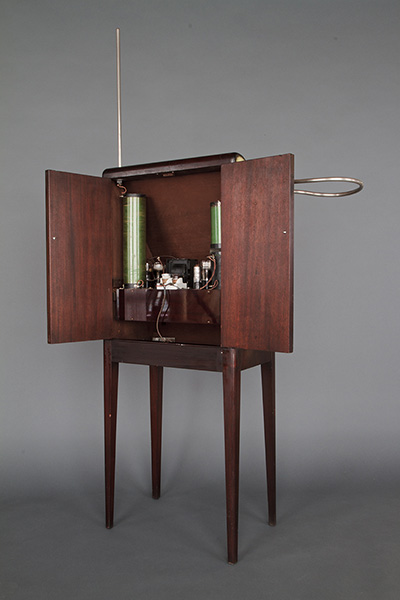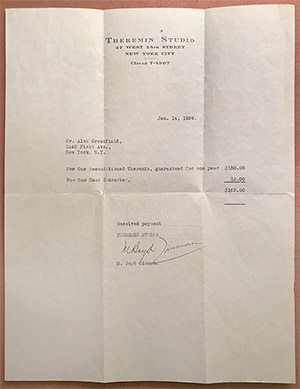RCATheremin.com
1929–30 Greenfield Theremin

Who Commissioned This Instrument?
Currently unknown.
Who Owned This Instrument?
Sold to Alex Greenfield on 14 January, 1939 by Boyd Zinman, for $165.00 (over $3,000 in today’s currency).
Where is This Instrument Now?
Private Owner, New York
What Do We Know About This Instrument?
While nearly visually identical to a factory-made RCA Theremin from the outside, this instrument consists of a special-order cabinet containing handmade internals, originating from Theremin Studio at 37 W 54th St., New York, built sometime between 1929 and 1930.
Although the cabinet looks like a factory-made Jamestown Mantel Co. cabinet from an RCA Theremin, on closer inspection there are noticeable differences. It bears no manufacturer's label, has removable legs, and features different door construction, hinges, and veneering details, as well as some hidden construction details like blind tongue and groove joints in places where the Jamestown Mantel Co. cabinets do not.
This cabinet bears the roman numeral Ⅵ (6) on the doors and chassis rails, indicating that it might be from a small run of cabinets that Theremin Studio ordered for use as prototypes or custom theremins. According to Albert Glinsky in Theremin: Ether Music and Espionage, an internal RCA memo stated that it is believed that Mr. Theremin has a design of cabinet which he requests used for this outfit.
It is very probable that this cabinet is of that design.
Electronically, this theremin is very similar to the RCA Theremin, employing the same tube complement, similar oscillator frequencies, and same principles for generating sound and controlling volume. We have observed, however, that the overall performance is superior to the factory production run, likely due to the handmade character and Theremin's personal attention to this instrument.
All of the electronics are mounted to the same wooden breadboard
style chassis including the power supply, which on the RCA production is mounted to the floor of the instrument's cabinet. The pitch and volume resonant coils are wound on cardboard tubes, hand-painted black at the exposed ends. The passive electronic parts are atypical of the RCA production, being high quality and sometimes laboratory-grade components, thoughtfully selected from independent suppliers of the day.

Why is it Special?
This theremin has been in the same family for over 80 years, ever since its sale in 1939 by Theremin’s business partner, Boyd Zinman.
From the original sales receipt and from comparisons with other Lev-built theremins of this design, we can see that the original power supply was replaced sometime before being sold; For One Reconditioned Theremin, guaranteed for one year.
Based on our observations, the quality of the electronic reconditioning does not measure up to Theremin’s high standards, so was likely performed after his departure from the United States in late 1938. Restoration work by Andrew Baron has brought the instrument back to full functionality.
It is also possible that this instrument is one of the ten Victor Theremins that performed at Carnegie Hall on April 25th, 1930 (albeit with custom-built internals). Evidence to suggest this is the presence of the handwritten number 2, located in two places in and on the cabinet, suggesting placement amongst the ten theremins on stage.
Lev's hand-written notes and test measurements can be found on the tubes. Two tubes have the words old lamp from new inst[rument]
written in pencil on the paper labels. December 4, 1930 dated Serco labels have also been discovered on the full tube set of a similar Lev-Built theremin. Finally, the cabinet legs bear the distinctive script of Lev's handwritten front left
, front right
, and back right
in pencil, only visible when the legs are removed.
The presence of four small holes on the inside, right cabinet door indicates
that a paper label was once attached, possibly displaying something similar to the North Carolina
or the Theremin Studio
Lev-built theremins.
Tube Complement:
- 80 (1), 27 (3), 24A (1), 99 (1), 71A (2)
- This tube lineup is the same as the RCA with the exception of the 99.
- Total tube count: 8
- Audio output power: single-ended 71A
Schematic
Not currently available, but predominately similar to the RCA factory schematic, with minor differences.






























-thumb.jpg)